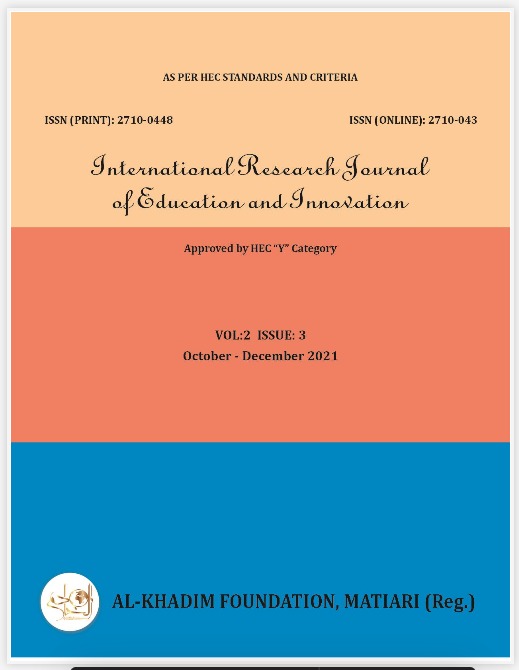Examining the Relationship Between Access to Home Amenities and Students' Academic Achievement at the Secondary Level
Keywords:
Household access to amenities, academic achievement, secondary school students, technology access, educational equityAbstract
This study examined the relationship between access to home amenities and students' achievement at the secondary level. Data was gathered from 340 students with different access levels to basic home amenities such as electricity and more sophisticated facilities like personal computers and the Internet. Regression analysis was applied to find a relationship between students' access to amenities and academic achievement, with an approximate 3% change in academic performance explained by resource availability at home. The beta value was negative (-0.174), indicating that despite the importance of access to amenities, other factors must play a more significant role: family income, parental involvement, and socio-economic context would all likely significantly influence academic success. The findings highlight the necessity of adequate support programs and policies for educational inequalities, especially in poor households. The research suggests increasing access to technology, developing all-rounded student support systems, and improving parental involvement for academic success among students from different socio-economic backgrounds.
References
Baker, D. P., Goesling, B., & LeTendre, G. K. (2016). The impact of global educational reforms on the home environment and learning outcomes in secondary education. Comparative Education Review, 60(4), 523–540. https://doi.org/10.1086/688636
Chatterji, M. (2006). The impact of home environment and family characteristics on student performance: Evidence from a national sample. Journal of Educational Psychology, 98(2), 500–510. https://doi.org/10.1037/0022-0663.98.2.500
Creswell, J. W. (2014). Research design: Qualitative, quantitative, and mixed methods approaches (4th ed.). SAGE Publications.
Crosnoe, R. (2021). Low-income students and the college access movement. The Future of Children, 32(2), 143-166. https://doi.org/10.1353/foc.0.0031
Davis-Kean, P. E. (2021). Parent education and family income influence child achievement: The indirect role of parental expectations and the home environment. Journal of Family Psychology, 19(2), 294–304. https://doi.org/10.1037/0893-3200.19.2.294
Etikan, I., Musa, S. A., & Alkassim, R. S. (2016). Comparison of convenience sampling and purposive sampling. American Journal of Theoretical and Applied Statistics, 5(1), 1-4. https://doi.org/10.11648/j.ajtas.20160501.11
Evans, G. W. (2020). The environment of childhood poverty. American Psychologist, 59(2), 77-92. https://doi.org/10.1037/0003-066X.59.2.77
Fitzpatrick, K. M., & Rausch, A. M. (2015). Parental income, family structure, and children's academic achievement. Sociology of Education, 88(4), 342–364. https://doi.org/10.1177/0038040715600331
Jensen, E. (2009). Teaching with poverty in mind: What being poor does to kids' brains and what schools can do about it. ASCD.
Jeynes, W. H. (2020). The relationship between parental involvement and secondary school students' academic achievement: A meta-analysis. Educational Psychology Review, 32(1), 1–24. https://doi.org/10.1007/s10648-020-09457-w
OECD. (2021). The digital transformation of education: Current and future trends in online learning. OECD Publishing. https://doi.org/10.1787/6c9e9a3a-en
Rivkin, S. G., Hanushek, E. A., & Kain, J. F. (2005). Teachers, schools, and academic performance. Econometrica, 73(2), 417–458. https://doi.org/10.1111/j.1468-0327.2005.00584.x
Rosen, L. D., Lim, A. F., Carrier, L. M., & Cheever, N. A. (2021). An empirical examination of the educational impact of text message-induced task switching in the classroom. Computers in Human Behavior, 27(3), 1082-1091. https://doi.org/10.1016/j.chb.2010.12.002
Sirin, S. R. (2021). Socioeconomic status and academic achievement: A meta-analytic review. Review of Educational Research, 75(3), 417–453. https://doi.org/10.3102/00346543075003417
Taylor, M., & McKenna, A. (2021). Parental involvement and academic achievement: A meta-analysis. Educational Psychology Review, 28(3), 483–505. https://doi.org/10.1007/s10648-016-9334-6
Zimmerman, B. J. (2021). Becoming a self-regulated learner: An overview. Theory into Practice, 41(2), 64–70. https://doi.org/10.1207/s15430421tip4102_2





